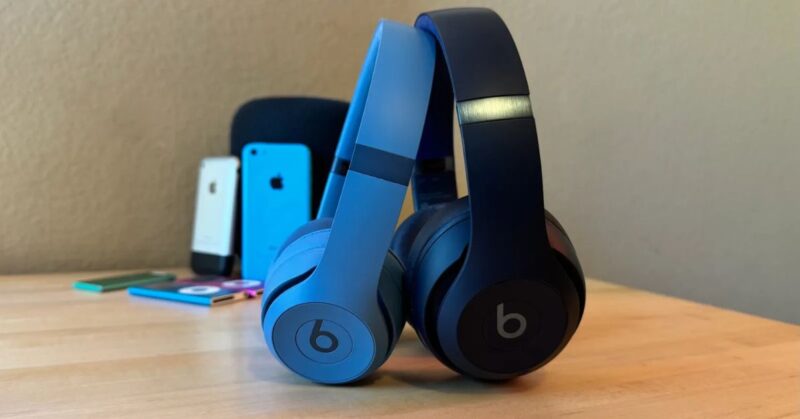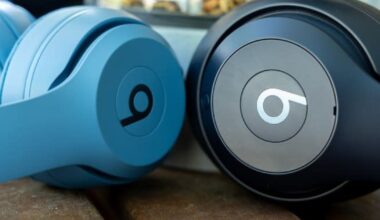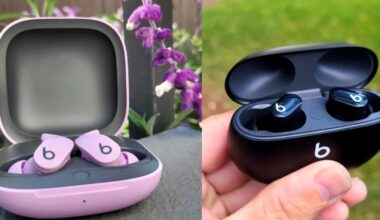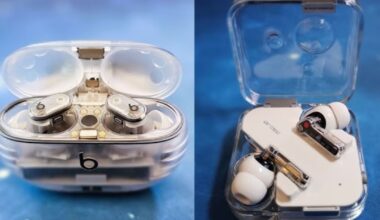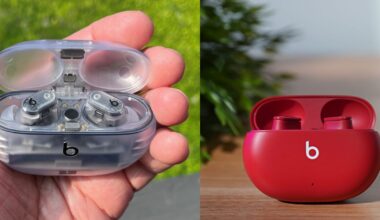When it comes to stylish and powerful on-ear headphones, Beats has been a go-to name for years. The Beats Solo 3 Wireless has had a long run as a favorite among music enthusiasts. But with the launch of the Beats Solo 4, everyone is now wondering, what’s the actual difference between Beats Solo 3 and 4, and is the upgrade worth it?
In this in-depth comparison, we dissect each aspect of Beats Solo 3 vs Solo 4 such as design, sound, battery, comfort, and features. If you’re stuck deciding between the two or questioning if it’s time to upgrade, this guide’s got you covered.
Which One to Buy: Beats Solo 3 or Solo 4?
When deciding between Beats Solo 3 vs Solo 4, the decision mostly comes down to whether you prioritize affordability or new features. Here’s a quick rundown to assist you in making a decision:
If you prefer for Beats Solo 3:
- USB-C charging and digital audio compatibility
- Enhanced sound clarity with a better-balanced profile
- Much longer battery life (up to 84 hours)
- Future-proof Bluetooth 5.3 connectivity
- More comfortable construction and smoother design
If you prefer for Beats Solo 3:
- Lower price tag (if still in stock)
- Bass-forward sound characteristic of vintage Beats tuning
- Familiar design with a 3.5mm headphone jack
- Solid performance for everyday use
Whereas both headphones are light and use the same signature on-ear design, Solo 4 is an improvement from the inside when it comes to internal hardware to make it compatible with today’s users.
Read More: Difference Between Beats Studio Buds Plus vs. Beats Fit Pro
Design and Build Quality
Both the Solo 3 and Solo 4 bear Beats’ signature minimalist, sleek design. On initial inspection, there are hardly any differences between the two versions. The overall build still retains a lightweight, foldable form with soft ear cushions and an adjustable headband. The Solo 4 boasts marginally better padding, but not by much.
If you enjoyed the Solo 3’s feel, the Solo 4 won’t be a huge departure. Both are small and lightweight, so they’re well-suited for use on the go. Where the materials and appearance are almost identical, the Solo 4 does provide slight improvements in long-term comfort and durability.
Comfort and Fit
As on-ear headphones, both designs push directly onto your ears instead of enveloping them. This can at times be uncomfortable when used for long periods. Beats has attempted to soften the ear cushions on the Solo 4, though. While not significantly different from the Solo 3, it might make a difference for people who wear them for hours on end.
The clamping pressure is equal in both versions, so the fit is secure enough for commuting or walking. Neither version is made for sports or heavy activity, but both provide a firm and consistent fit for general listening.
Sound Quality
Sound performance is the primary distinction between the Beats Solo3 Wireless on-ear headphones vs Solo4. Although both provide Beats’ characteristic punchy bass, the Solo 4 has a better-balanced sound profile.
The Solo 3 has a heavier bottom-end emphasis, which music lovers who enjoy bass will appreciate but could overpower mids and highs. The Solo 4, on the other hand, is cleaner and more precise-sounding. It doesn’t forego the bottom-end bias but does find a way to allot more room for vocals and instruments. This makes the Solo 4 a more suitable choice for a broader variety of genres.
If you’re thinking whether to use Beats Solo 3 or 4, the choice is yours. If you prefer deep bass and powerful beats, the Solo 3 performs well. If you prefer a balanced and detailed sound, the Solo 4 prevails.
Also Read: Beats Studio Pro Vs Beats Solo 4
Battery Life
One of the most significant advancements in the Solo 4 is battery life. The Beats Solo 3 already impressed, boasting up to 40–45 hours of playtime. The Beats Solo 4 goes a step further and provides up to 50 hours on Bluetooth, as well as over 80 hours on USB-C audio.
This is a great leap and addresses the popular question: how long Beats Solo 4 battery lasts. It lasts longer than the majority of competitors within the on-ear category. If battery longevity is your thing, the Solo 4 is among the top available today.
Charging and Connectivity
This is where the gap between Beats Solo 3 and 4 becomes most apparent. The Solo 3 is charged via a micro-USB cable, which in 2025 seems old. It also has only Bluetooth 4.2, which is slower and less efficient than later standards.
Conversely, the Beats Solo 4 ultimately introduces USB-C charging, aligning with new devices. It also employs Bluetooth 5.3, enhancing connectivity range, speed, and battery life.
Another new feature is the inclusion of USB-C audio in Solo 4. You can now directly plug in using USB-C for lossless audio, which the Solo 3 lacks. The Solo 4 lacks a 3.5mm headphone jack, but this is a response to the industry standard moving toward digital audio.
Microphone and Call Quality
Both have a call microphone and support for voice assistants. The Solo 4 has marginally improved call quality due to improved noise cancellation and newer internals. While neither is suitable for professional-level conferencing or recording, both do a decent job with casual calls and voice command inputs.
Smart Features and Integration
Both of the headphones are Apple device optimized. The Solo 3 utilizes Apple’s W1 chip, providing simple pairing and compatibility with iPhones, iPads, and Macs. The Solo 4 features the H1 chip, which provides quicker pairing, improved connectivity, and support for “Hey Siri” voice control.
Android owners can still take advantage of minimal Bluetooth functionality, but without the extensive ecosystem support of Apple hardware. The Android version of the Beats app does permit firmware upgrades and simple control, but there is no custom EQ for either device.
Noise Isolation
Neither the Solo 3 nor Solo 4 has Active Noise Cancellation (ANC). They use passive noise isolation, which is good for on-ear headphones but not great. The upgraded ear cushions on the Solo 4 might offer slightly better noise isolation, but not by much.
If ANC is essential, then you can consider alternatives like Beats Studio Pro or earbuds like Beats Fit Pro.
Also Read: Beats Studio Buds Plus Vs Nothing Ear a
Colors and Customization
Beats Solo 3 has existed for years and had a myriad of colors to offer, among which was the coveted Solo 3 Beats Green. The stock can vary at this time since it begins phasing out from mainstream retailers.
The Solo 4 comes in limited colors upon release, which are Matte Black, Slate Blue, and Cloud Pink. Additional colors might be launched later.
Price Comparison
- Beats Solo 3: Usually on sale for about $129 or less (when available)
- Beats Solo 4: Release price around $199
Since the Solo 3 is being phased out, supply might become scarce. The Solo 4’s premium price tag is due to its newer features, longer battery life, and better sound and connectivity.
Check Post: Beats Studio Buds Plus Vs Beats Studio Buds
Winding Up!
If you already have the Solo 3 and it still serves your purpose, there’s no pressing need to upgrade. But for those looking for a future-proof on-ear headphone with improved audio, connectivity, and battery life, the Beats Solo 4 is the obvious choice.
It streamlines the Solo 3’s iconic look and improves on it with significant enhancements. As an iPhone owner or Android user, the Solo 4 offers greater value for the money—earmarking it as the wiser buy in 2025 and beyond.
Frequently Asked Questions (Beats Solo 3 Vs Solo 4)
A. No, neither the Beats Solo 3 nor Solo 4 has active noise cancelation (ANC). They provide simple passive noise isolation, but background noise is still audible—particularly because these are on-ear headphones.
A. No. Both pairs of headphones have an IP rating, so they are not water- or sweat-resistant. They’re good for casual listening but not ideal for serious workouts or use outside in the rain.
A. Yes, both headphones feature built-in microphones so you can take calls, record audio, or use voice assistants such as Siri or Google Assistant.
A. They can be worn while doing light exercises such as walking or light lifting, but because of the on-ear design and lack of water protection, they are not ideal for running or heavy sweats.
A. Yes, both headphones are compatible with Android phones and tablets using Bluetooth. Android’s Beats app also unlocks the extra features of the Beats Solo 4.
A. Yes. Both are compatible with wired listening using a 3.5mm headphone jack. The Beats Solo 4 even supports USB-C audio, giving you more flexibility.
A. The battery life of Beats Solo 3 is a maximum of 45 hours on full charge, whereas the Solo 4 lasts an impressive 84 hours. Thus, the Solo 4 is one of the longest on-ear headphones in its segment.
A. Yes. Both earbuds carry Beats’ Fast Fuel support. A 10-minute charge delivers up to 3 hours of playback—just what you need for instant fills.
A. The Solo 3 features Bluetooth 4.2, whereas the Solo 4 comes equipped with Bluetooth 5.3. The new version provides a better range, connection stability, and efficiency.
A. The Beats Solo 4 is the better choice in terms of battery, connectivity, and sound quality. It’s better for use on newer devices and into the future, although the Solo 3 is still a good budget-friendly option if it is on sale.
